Organisational Behaviour Report: Culture, Motivation & Team Dynamics
VerifiedAdded on 2023/01/23
|17
|4904
|37
Report
AI Summary
This report provides a comprehensive analysis of organisational behaviour within the context of A David & Corporation, a food and beverage company. It examines the impact of organisational culture, power, and politics on individual and team performance, referencing Handy's Culture Typology and French and Raven's Power Types. The report also delves into motivational theories, specifically Maslow's need hierarchy theory and the goal-setting theory, exploring how these theories can be applied to motivate employees. Furthermore, it discusses the characteristics of effective and ineffective teams, highlighting the importance of communication, trust, and shared goals. The report concludes by summarising key concepts and philosophies of organisational behaviour, offering insights into how organisations can create a positive and productive work environment. Desklib offers students access to solved assignments and study tools.
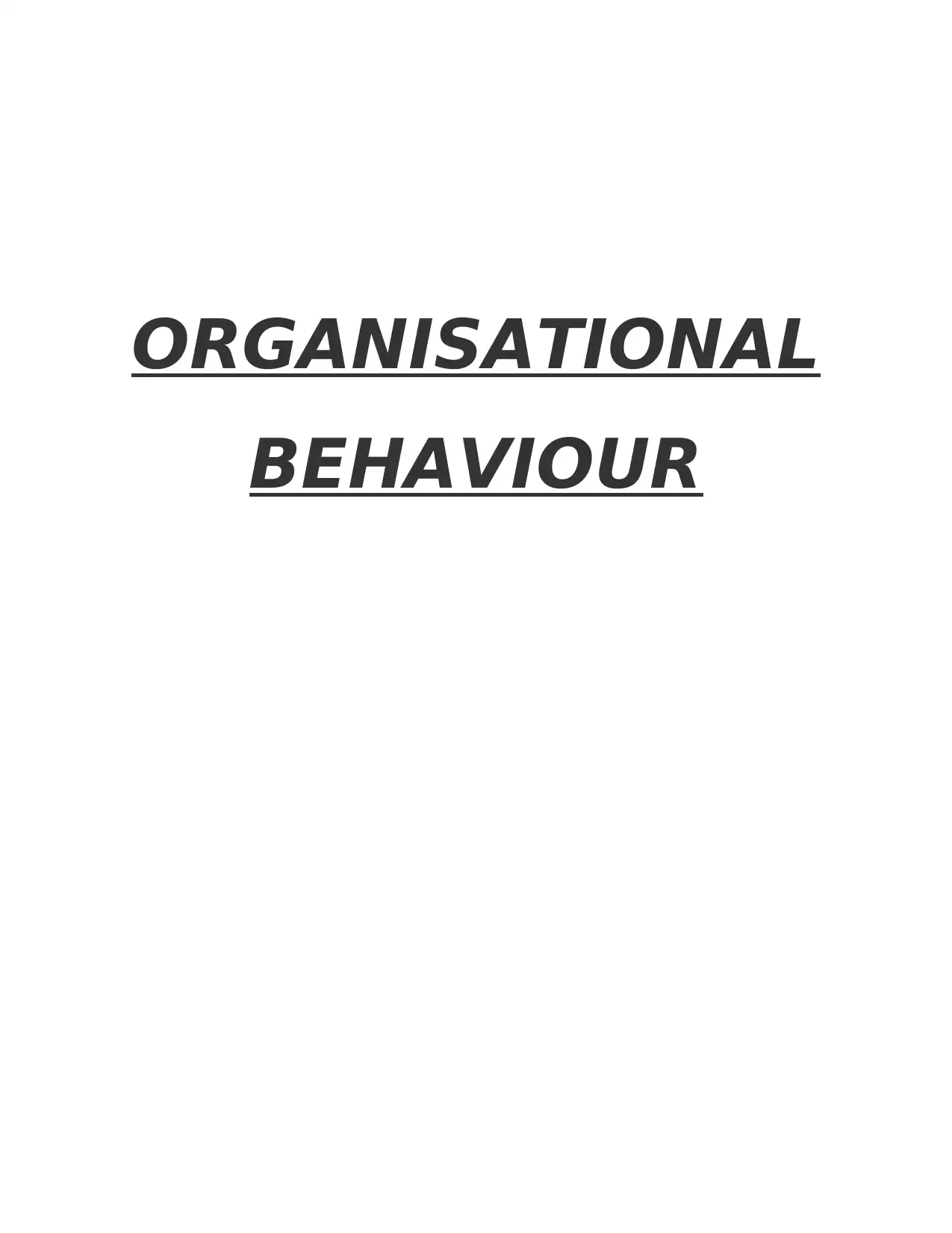
ORGANISATIONAL
BEHAVIOUR
BEHAVIOUR
Paraphrase This Document
Need a fresh take? Get an instant paraphrase of this document with our AI Paraphraser
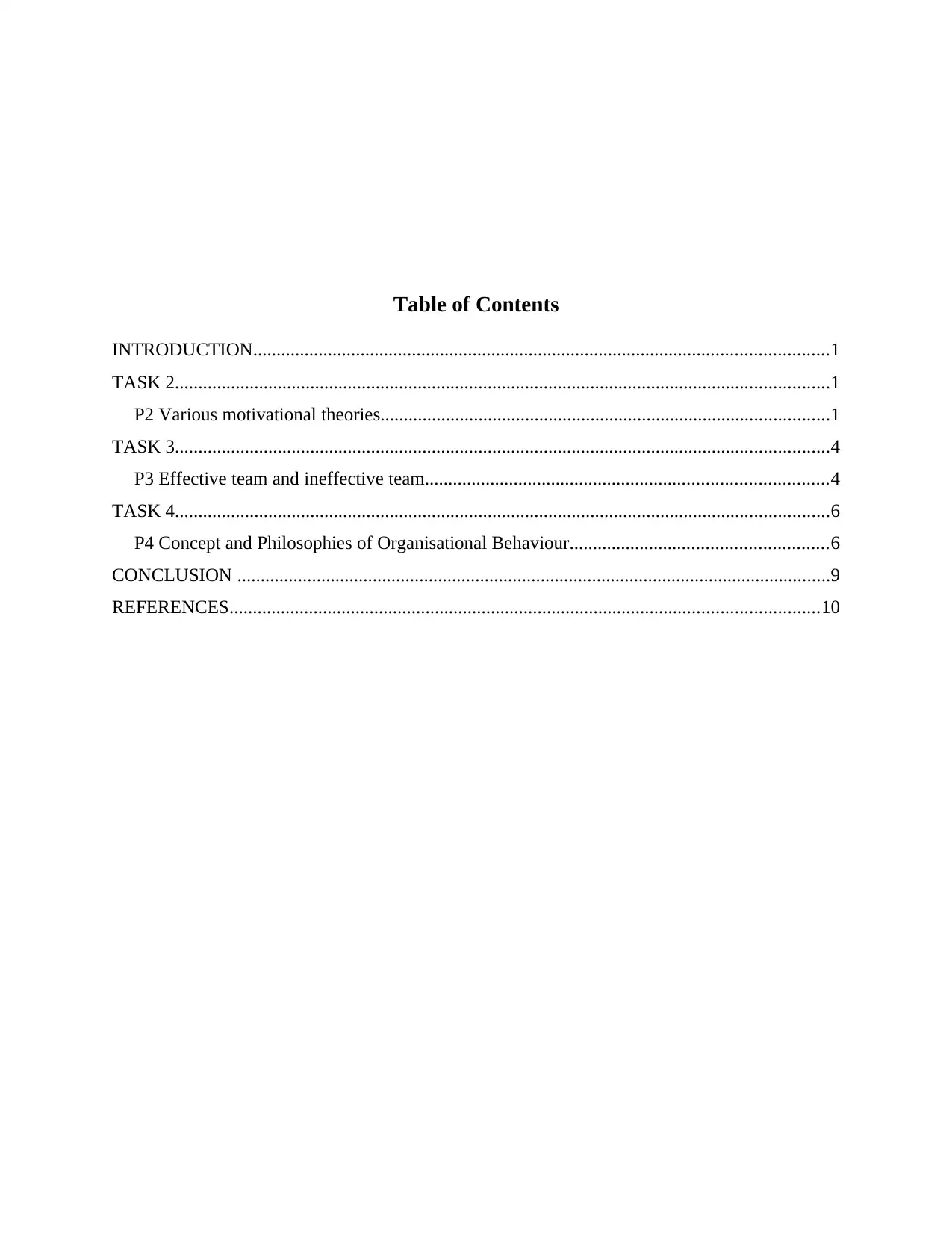
Table of Contents
INTRODUCTION...........................................................................................................................1
TASK 2............................................................................................................................................1
P2 Various motivational theories................................................................................................1
TASK 3............................................................................................................................................4
P3 Effective team and ineffective team......................................................................................4
TASK 4............................................................................................................................................6
P4 Concept and Philosophies of Organisational Behaviour.......................................................6
CONCLUSION ...............................................................................................................................9
REFERENCES..............................................................................................................................10
INTRODUCTION...........................................................................................................................1
TASK 2............................................................................................................................................1
P2 Various motivational theories................................................................................................1
TASK 3............................................................................................................................................4
P3 Effective team and ineffective team......................................................................................4
TASK 4............................................................................................................................................6
P4 Concept and Philosophies of Organisational Behaviour.......................................................6
CONCLUSION ...............................................................................................................................9
REFERENCES..............................................................................................................................10

⊘ This is a preview!⊘
Do you want full access?
Subscribe today to unlock all pages.

Trusted by 1+ million students worldwide
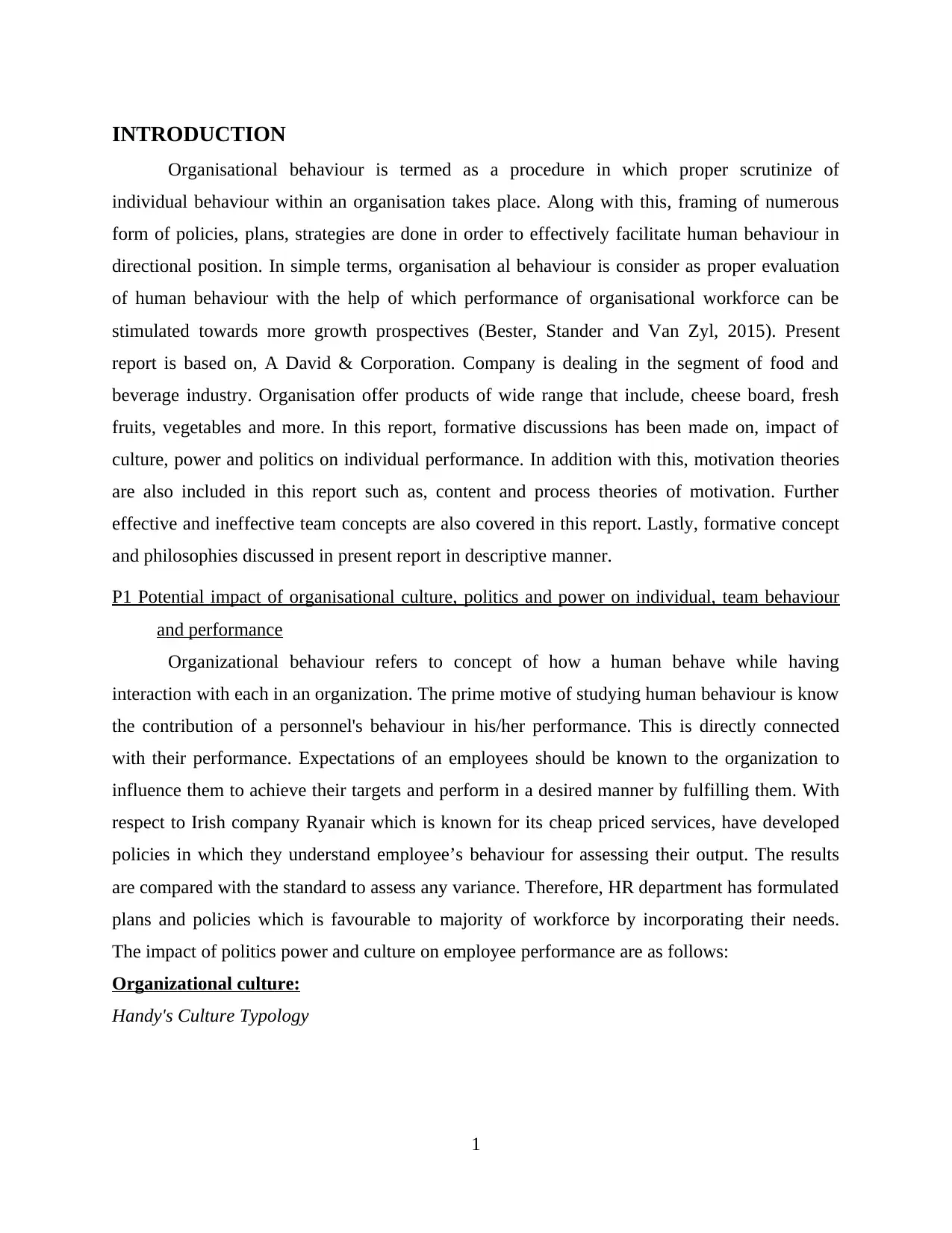
INTRODUCTION
Organisational behaviour is termed as a procedure in which proper scrutinize of
individual behaviour within an organisation takes place. Along with this, framing of numerous
form of policies, plans, strategies are done in order to effectively facilitate human behaviour in
directional position. In simple terms, organisation al behaviour is consider as proper evaluation
of human behaviour with the help of which performance of organisational workforce can be
stimulated towards more growth prospectives (Bester, Stander and Van Zyl, 2015). Present
report is based on, A David & Corporation. Company is dealing in the segment of food and
beverage industry. Organisation offer products of wide range that include, cheese board, fresh
fruits, vegetables and more. In this report, formative discussions has been made on, impact of
culture, power and politics on individual performance. In addition with this, motivation theories
are also included in this report such as, content and process theories of motivation. Further
effective and ineffective team concepts are also covered in this report. Lastly, formative concept
and philosophies discussed in present report in descriptive manner.
P1 Potential impact of organisational culture, politics and power on individual, team behaviour
and performance
Organizational behaviour refers to concept of how a human behave while having
interaction with each in an organization. The prime motive of studying human behaviour is know
the contribution of a personnel's behaviour in his/her performance. This is directly connected
with their performance. Expectations of an employees should be known to the organization to
influence them to achieve their targets and perform in a desired manner by fulfilling them. With
respect to Irish company Ryanair which is known for its cheap priced services, have developed
policies in which they understand employee’s behaviour for assessing their output. The results
are compared with the standard to assess any variance. Therefore, HR department has formulated
plans and policies which is favourable to majority of workforce by incorporating their needs.
The impact of politics power and culture on employee performance are as follows:
Organizational culture:
Handy's Culture Typology
1
Organisational behaviour is termed as a procedure in which proper scrutinize of
individual behaviour within an organisation takes place. Along with this, framing of numerous
form of policies, plans, strategies are done in order to effectively facilitate human behaviour in
directional position. In simple terms, organisation al behaviour is consider as proper evaluation
of human behaviour with the help of which performance of organisational workforce can be
stimulated towards more growth prospectives (Bester, Stander and Van Zyl, 2015). Present
report is based on, A David & Corporation. Company is dealing in the segment of food and
beverage industry. Organisation offer products of wide range that include, cheese board, fresh
fruits, vegetables and more. In this report, formative discussions has been made on, impact of
culture, power and politics on individual performance. In addition with this, motivation theories
are also included in this report such as, content and process theories of motivation. Further
effective and ineffective team concepts are also covered in this report. Lastly, formative concept
and philosophies discussed in present report in descriptive manner.
P1 Potential impact of organisational culture, politics and power on individual, team behaviour
and performance
Organizational behaviour refers to concept of how a human behave while having
interaction with each in an organization. The prime motive of studying human behaviour is know
the contribution of a personnel's behaviour in his/her performance. This is directly connected
with their performance. Expectations of an employees should be known to the organization to
influence them to achieve their targets and perform in a desired manner by fulfilling them. With
respect to Irish company Ryanair which is known for its cheap priced services, have developed
policies in which they understand employee’s behaviour for assessing their output. The results
are compared with the standard to assess any variance. Therefore, HR department has formulated
plans and policies which is favourable to majority of workforce by incorporating their needs.
The impact of politics power and culture on employee performance are as follows:
Organizational culture:
Handy's Culture Typology
1
Paraphrase This Document
Need a fresh take? Get an instant paraphrase of this document with our AI Paraphraser
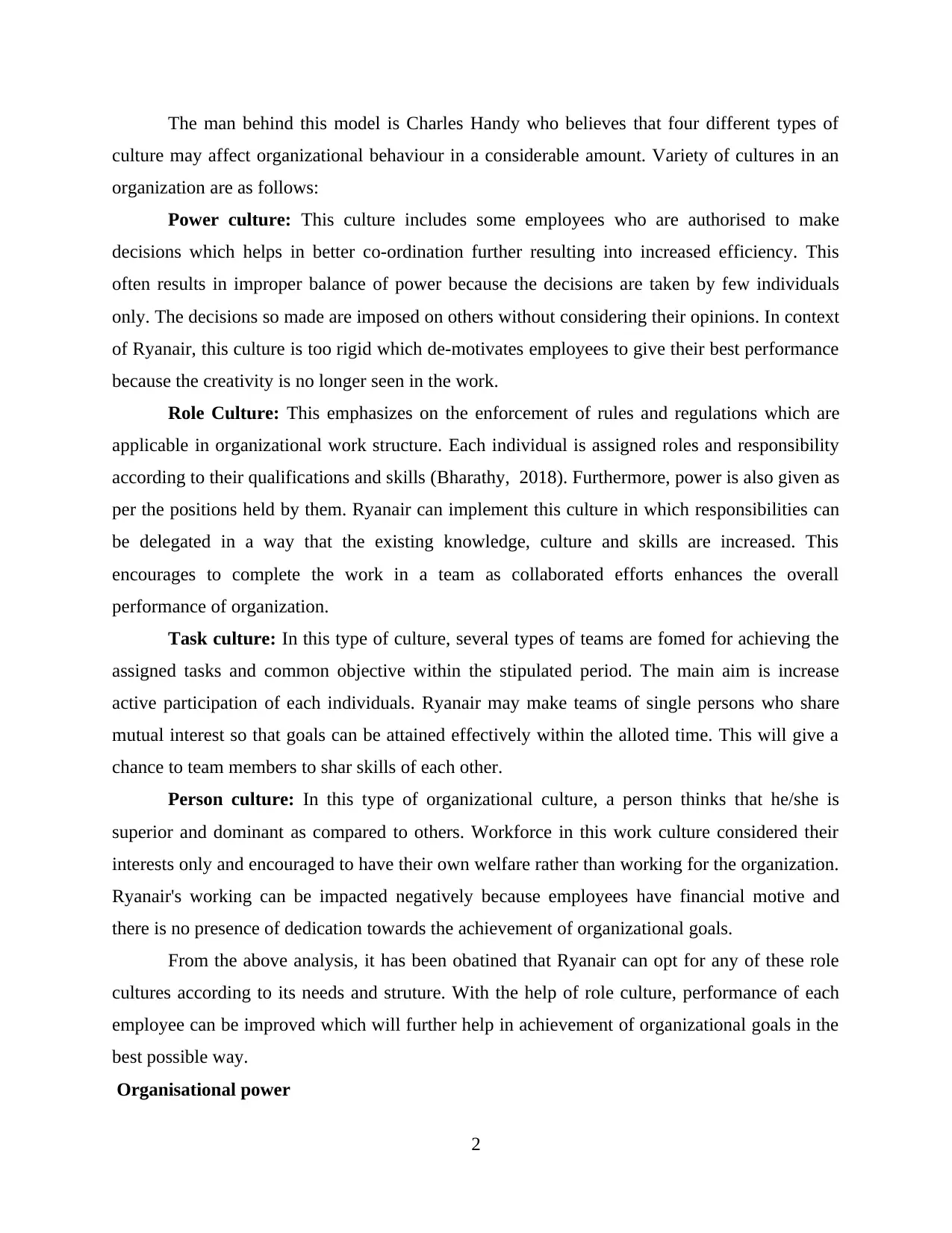
The man behind this model is Charles Handy who believes that four different types of
culture may affect organizational behaviour in a considerable amount. Variety of cultures in an
organization are as follows:
Power culture: This culture includes some employees who are authorised to make
decisions which helps in better co-ordination further resulting into increased efficiency. This
often results in improper balance of power because the decisions are taken by few individuals
only. The decisions so made are imposed on others without considering their opinions. In context
of Ryanair, this culture is too rigid which de-motivates employees to give their best performance
because the creativity is no longer seen in the work.
Role Culture: This emphasizes on the enforcement of rules and regulations which are
applicable in organizational work structure. Each individual is assigned roles and responsibility
according to their qualifications and skills (Bharathy, 2018). Furthermore, power is also given as
per the positions held by them. Ryanair can implement this culture in which responsibilities can
be delegated in a way that the existing knowledge, culture and skills are increased. This
encourages to complete the work in a team as collaborated efforts enhances the overall
performance of organization.
Task culture: In this type of culture, several types of teams are fomed for achieving the
assigned tasks and common objective within the stipulated period. The main aim is increase
active participation of each individuals. Ryanair may make teams of single persons who share
mutual interest so that goals can be attained effectively within the alloted time. This will give a
chance to team members to shar skills of each other.
Person culture: In this type of organizational culture, a person thinks that he/she is
superior and dominant as compared to others. Workforce in this work culture considered their
interests only and encouraged to have their own welfare rather than working for the organization.
Ryanair's working can be impacted negatively because employees have financial motive and
there is no presence of dedication towards the achievement of organizational goals.
From the above analysis, it has been obatined that Ryanair can opt for any of these role
cultures according to its needs and struture. With the help of role culture, performance of each
employee can be improved which will further help in achievement of organizational goals in the
best possible way.
Organisational power
2
culture may affect organizational behaviour in a considerable amount. Variety of cultures in an
organization are as follows:
Power culture: This culture includes some employees who are authorised to make
decisions which helps in better co-ordination further resulting into increased efficiency. This
often results in improper balance of power because the decisions are taken by few individuals
only. The decisions so made are imposed on others without considering their opinions. In context
of Ryanair, this culture is too rigid which de-motivates employees to give their best performance
because the creativity is no longer seen in the work.
Role Culture: This emphasizes on the enforcement of rules and regulations which are
applicable in organizational work structure. Each individual is assigned roles and responsibility
according to their qualifications and skills (Bharathy, 2018). Furthermore, power is also given as
per the positions held by them. Ryanair can implement this culture in which responsibilities can
be delegated in a way that the existing knowledge, culture and skills are increased. This
encourages to complete the work in a team as collaborated efforts enhances the overall
performance of organization.
Task culture: In this type of culture, several types of teams are fomed for achieving the
assigned tasks and common objective within the stipulated period. The main aim is increase
active participation of each individuals. Ryanair may make teams of single persons who share
mutual interest so that goals can be attained effectively within the alloted time. This will give a
chance to team members to shar skills of each other.
Person culture: In this type of organizational culture, a person thinks that he/she is
superior and dominant as compared to others. Workforce in this work culture considered their
interests only and encouraged to have their own welfare rather than working for the organization.
Ryanair's working can be impacted negatively because employees have financial motive and
there is no presence of dedication towards the achievement of organizational goals.
From the above analysis, it has been obatined that Ryanair can opt for any of these role
cultures according to its needs and struture. With the help of role culture, performance of each
employee can be improved which will further help in achievement of organizational goals in the
best possible way.
Organisational power
2
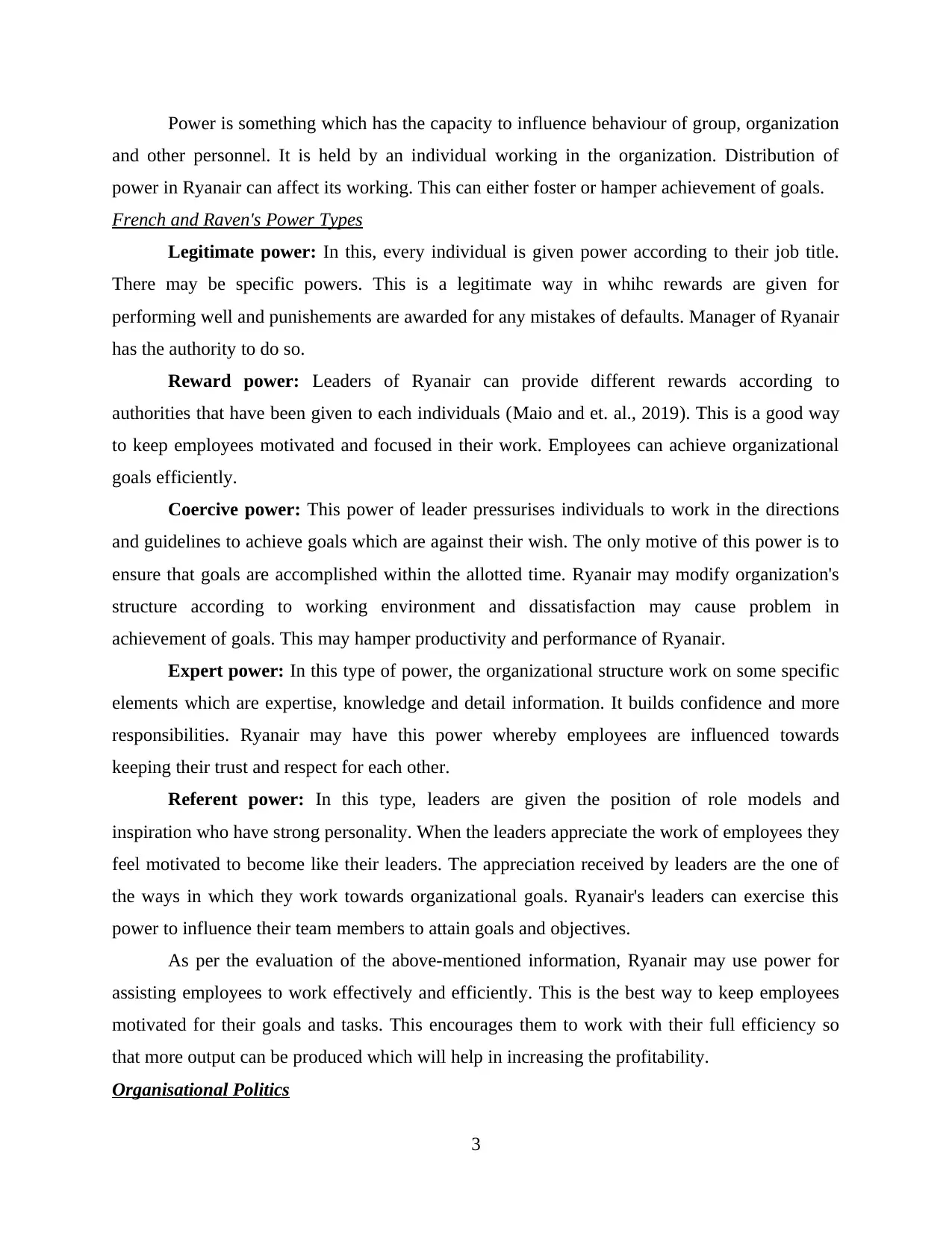
Power is something which has the capacity to influence behaviour of group, organization
and other personnel. It is held by an individual working in the organization. Distribution of
power in Ryanair can affect its working. This can either foster or hamper achievement of goals.
French and Raven's Power Types
Legitimate power: In this, every individual is given power according to their job title.
There may be specific powers. This is a legitimate way in whihc rewards are given for
performing well and punishements are awarded for any mistakes of defaults. Manager of Ryanair
has the authority to do so.
Reward power: Leaders of Ryanair can provide different rewards according to
authorities that have been given to each individuals (Maio and et. al., 2019). This is a good way
to keep employees motivated and focused in their work. Employees can achieve organizational
goals efficiently.
Coercive power: This power of leader pressurises individuals to work in the directions
and guidelines to achieve goals which are against their wish. The only motive of this power is to
ensure that goals are accomplished within the allotted time. Ryanair may modify organization's
structure according to working environment and dissatisfaction may cause problem in
achievement of goals. This may hamper productivity and performance of Ryanair.
Expert power: In this type of power, the organizational structure work on some specific
elements which are expertise, knowledge and detail information. It builds confidence and more
responsibilities. Ryanair may have this power whereby employees are influenced towards
keeping their trust and respect for each other.
Referent power: In this type, leaders are given the position of role models and
inspiration who have strong personality. When the leaders appreciate the work of employees they
feel motivated to become like their leaders. The appreciation received by leaders are the one of
the ways in which they work towards organizational goals. Ryanair's leaders can exercise this
power to influence their team members to attain goals and objectives.
As per the evaluation of the above-mentioned information, Ryanair may use power for
assisting employees to work effectively and efficiently. This is the best way to keep employees
motivated for their goals and tasks. This encourages them to work with their full efficiency so
that more output can be produced which will help in increasing the profitability.
Organisational Politics
3
and other personnel. It is held by an individual working in the organization. Distribution of
power in Ryanair can affect its working. This can either foster or hamper achievement of goals.
French and Raven's Power Types
Legitimate power: In this, every individual is given power according to their job title.
There may be specific powers. This is a legitimate way in whihc rewards are given for
performing well and punishements are awarded for any mistakes of defaults. Manager of Ryanair
has the authority to do so.
Reward power: Leaders of Ryanair can provide different rewards according to
authorities that have been given to each individuals (Maio and et. al., 2019). This is a good way
to keep employees motivated and focused in their work. Employees can achieve organizational
goals efficiently.
Coercive power: This power of leader pressurises individuals to work in the directions
and guidelines to achieve goals which are against their wish. The only motive of this power is to
ensure that goals are accomplished within the allotted time. Ryanair may modify organization's
structure according to working environment and dissatisfaction may cause problem in
achievement of goals. This may hamper productivity and performance of Ryanair.
Expert power: In this type of power, the organizational structure work on some specific
elements which are expertise, knowledge and detail information. It builds confidence and more
responsibilities. Ryanair may have this power whereby employees are influenced towards
keeping their trust and respect for each other.
Referent power: In this type, leaders are given the position of role models and
inspiration who have strong personality. When the leaders appreciate the work of employees they
feel motivated to become like their leaders. The appreciation received by leaders are the one of
the ways in which they work towards organizational goals. Ryanair's leaders can exercise this
power to influence their team members to attain goals and objectives.
As per the evaluation of the above-mentioned information, Ryanair may use power for
assisting employees to work effectively and efficiently. This is the best way to keep employees
motivated for their goals and tasks. This encourages them to work with their full efficiency so
that more output can be produced which will help in increasing the profitability.
Organisational Politics
3
⊘ This is a preview!⊘
Do you want full access?
Subscribe today to unlock all pages.

Trusted by 1+ million students worldwide
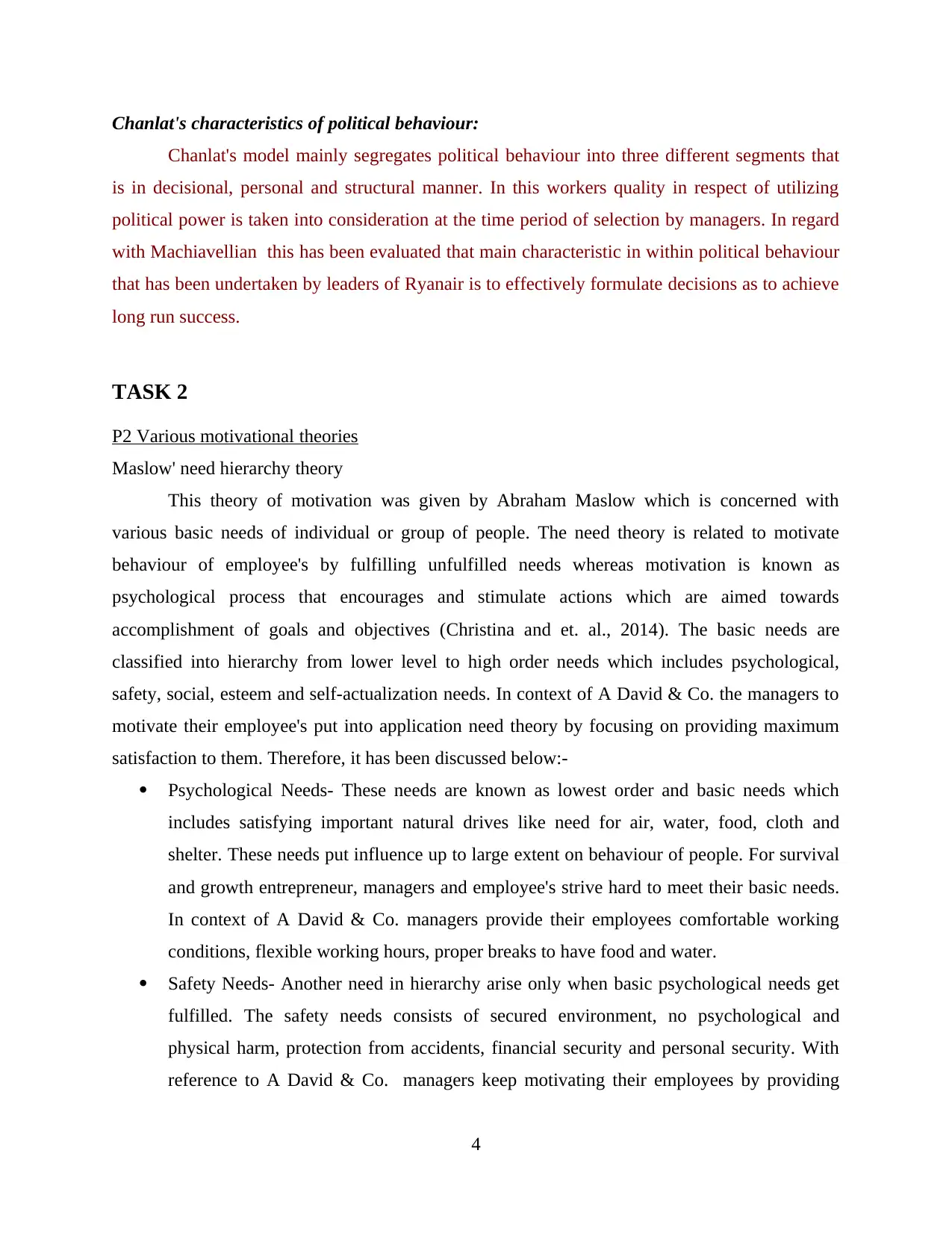
Chanlat's characteristics of political behaviour:
Chanlat's model mainly segregates political behaviour into three different segments that
is in decisional, personal and structural manner. In this workers quality in respect of utilizing
political power is taken into consideration at the time period of selection by managers. In regard
with Machiavellian this has been evaluated that main characteristic in within political behaviour
that has been undertaken by leaders of Ryanair is to effectively formulate decisions as to achieve
long run success.
TASK 2
P2 Various motivational theories
Maslow' need hierarchy theory
This theory of motivation was given by Abraham Maslow which is concerned with
various basic needs of individual or group of people. The need theory is related to motivate
behaviour of employee's by fulfilling unfulfilled needs whereas motivation is known as
psychological process that encourages and stimulate actions which are aimed towards
accomplishment of goals and objectives (Christina and et. al., 2014). The basic needs are
classified into hierarchy from lower level to high order needs which includes psychological,
safety, social, esteem and self-actualization needs. In context of A David & Co. the managers to
motivate their employee's put into application need theory by focusing on providing maximum
satisfaction to them. Therefore, it has been discussed below:-
Psychological Needs- These needs are known as lowest order and basic needs which
includes satisfying important natural drives like need for air, water, food, cloth and
shelter. These needs put influence up to large extent on behaviour of people. For survival
and growth entrepreneur, managers and employee's strive hard to meet their basic needs.
In context of A David & Co. managers provide their employees comfortable working
conditions, flexible working hours, proper breaks to have food and water.
Safety Needs- Another need in hierarchy arise only when basic psychological needs get
fulfilled. The safety needs consists of secured environment, no psychological and
physical harm, protection from accidents, financial security and personal security. With
reference to A David & Co. managers keep motivating their employees by providing
4
Chanlat's model mainly segregates political behaviour into three different segments that
is in decisional, personal and structural manner. In this workers quality in respect of utilizing
political power is taken into consideration at the time period of selection by managers. In regard
with Machiavellian this has been evaluated that main characteristic in within political behaviour
that has been undertaken by leaders of Ryanair is to effectively formulate decisions as to achieve
long run success.
TASK 2
P2 Various motivational theories
Maslow' need hierarchy theory
This theory of motivation was given by Abraham Maslow which is concerned with
various basic needs of individual or group of people. The need theory is related to motivate
behaviour of employee's by fulfilling unfulfilled needs whereas motivation is known as
psychological process that encourages and stimulate actions which are aimed towards
accomplishment of goals and objectives (Christina and et. al., 2014). The basic needs are
classified into hierarchy from lower level to high order needs which includes psychological,
safety, social, esteem and self-actualization needs. In context of A David & Co. the managers to
motivate their employee's put into application need theory by focusing on providing maximum
satisfaction to them. Therefore, it has been discussed below:-
Psychological Needs- These needs are known as lowest order and basic needs which
includes satisfying important natural drives like need for air, water, food, cloth and
shelter. These needs put influence up to large extent on behaviour of people. For survival
and growth entrepreneur, managers and employee's strive hard to meet their basic needs.
In context of A David & Co. managers provide their employees comfortable working
conditions, flexible working hours, proper breaks to have food and water.
Safety Needs- Another need in hierarchy arise only when basic psychological needs get
fulfilled. The safety needs consists of secured environment, no psychological and
physical harm, protection from accidents, financial security and personal security. With
reference to A David & Co. managers keep motivating their employees by providing
4
Paraphrase This Document
Need a fresh take? Get an instant paraphrase of this document with our AI Paraphraser
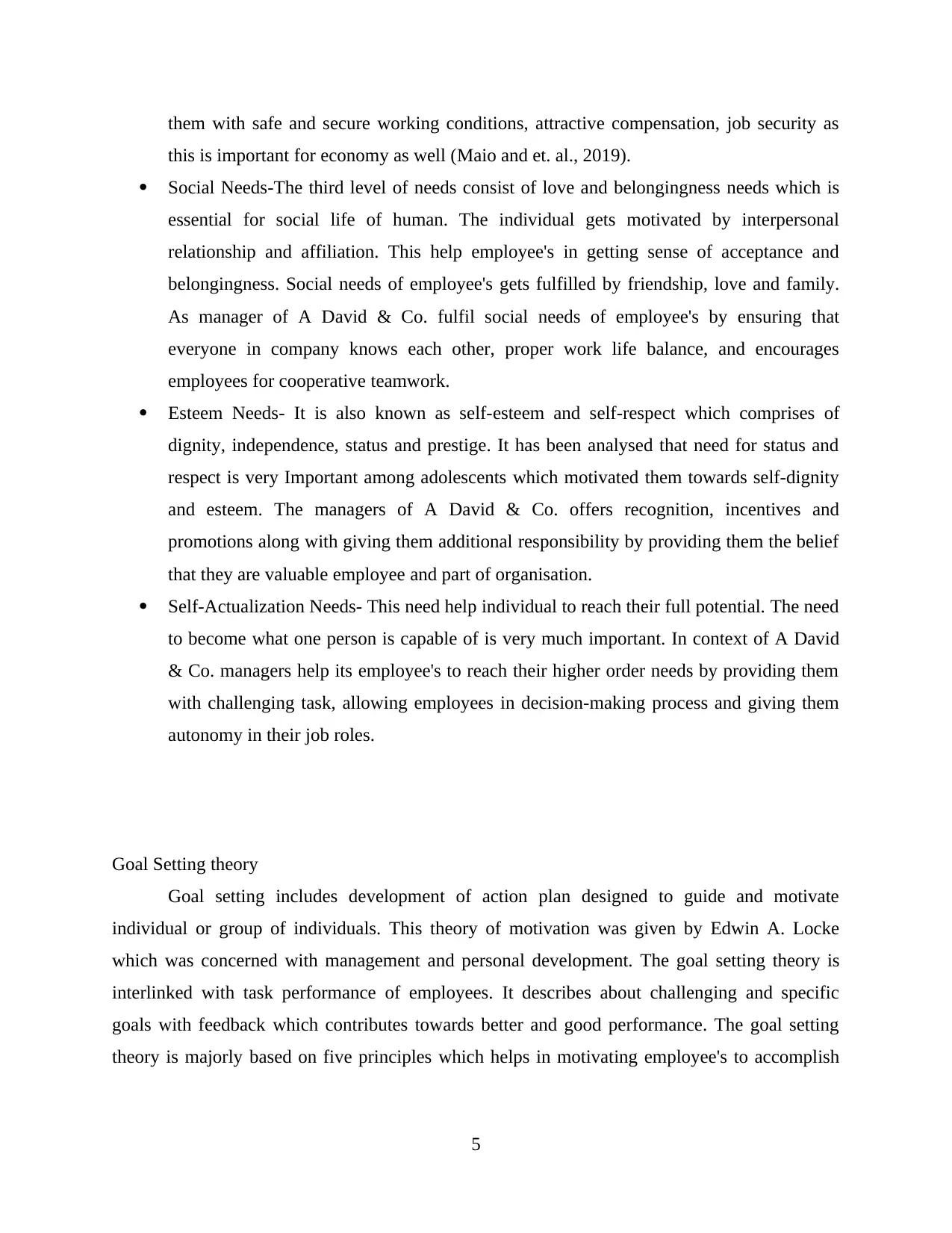
them with safe and secure working conditions, attractive compensation, job security as
this is important for economy as well (Maio and et. al., 2019).
Social Needs-The third level of needs consist of love and belongingness needs which is
essential for social life of human. The individual gets motivated by interpersonal
relationship and affiliation. This help employee's in getting sense of acceptance and
belongingness. Social needs of employee's gets fulfilled by friendship, love and family.
As manager of A David & Co. fulfil social needs of employee's by ensuring that
everyone in company knows each other, proper work life balance, and encourages
employees for cooperative teamwork.
Esteem Needs- It is also known as self-esteem and self-respect which comprises of
dignity, independence, status and prestige. It has been analysed that need for status and
respect is very Important among adolescents which motivated them towards self-dignity
and esteem. The managers of A David & Co. offers recognition, incentives and
promotions along with giving them additional responsibility by providing them the belief
that they are valuable employee and part of organisation.
Self-Actualization Needs- This need help individual to reach their full potential. The need
to become what one person is capable of is very much important. In context of A David
& Co. managers help its employee's to reach their higher order needs by providing them
with challenging task, allowing employees in decision-making process and giving them
autonomy in their job roles.
Goal Setting theory
Goal setting includes development of action plan designed to guide and motivate
individual or group of individuals. This theory of motivation was given by Edwin A. Locke
which was concerned with management and personal development. The goal setting theory is
interlinked with task performance of employees. It describes about challenging and specific
goals with feedback which contributes towards better and good performance. The goal setting
theory is majorly based on five principles which helps in motivating employee's to accomplish
5
this is important for economy as well (Maio and et. al., 2019).
Social Needs-The third level of needs consist of love and belongingness needs which is
essential for social life of human. The individual gets motivated by interpersonal
relationship and affiliation. This help employee's in getting sense of acceptance and
belongingness. Social needs of employee's gets fulfilled by friendship, love and family.
As manager of A David & Co. fulfil social needs of employee's by ensuring that
everyone in company knows each other, proper work life balance, and encourages
employees for cooperative teamwork.
Esteem Needs- It is also known as self-esteem and self-respect which comprises of
dignity, independence, status and prestige. It has been analysed that need for status and
respect is very Important among adolescents which motivated them towards self-dignity
and esteem. The managers of A David & Co. offers recognition, incentives and
promotions along with giving them additional responsibility by providing them the belief
that they are valuable employee and part of organisation.
Self-Actualization Needs- This need help individual to reach their full potential. The need
to become what one person is capable of is very much important. In context of A David
& Co. managers help its employee's to reach their higher order needs by providing them
with challenging task, allowing employees in decision-making process and giving them
autonomy in their job roles.
Goal Setting theory
Goal setting includes development of action plan designed to guide and motivate
individual or group of individuals. This theory of motivation was given by Edwin A. Locke
which was concerned with management and personal development. The goal setting theory is
interlinked with task performance of employees. It describes about challenging and specific
goals with feedback which contributes towards better and good performance. The goal setting
theory is majorly based on five principles which helps in motivating employee's to accomplish
5
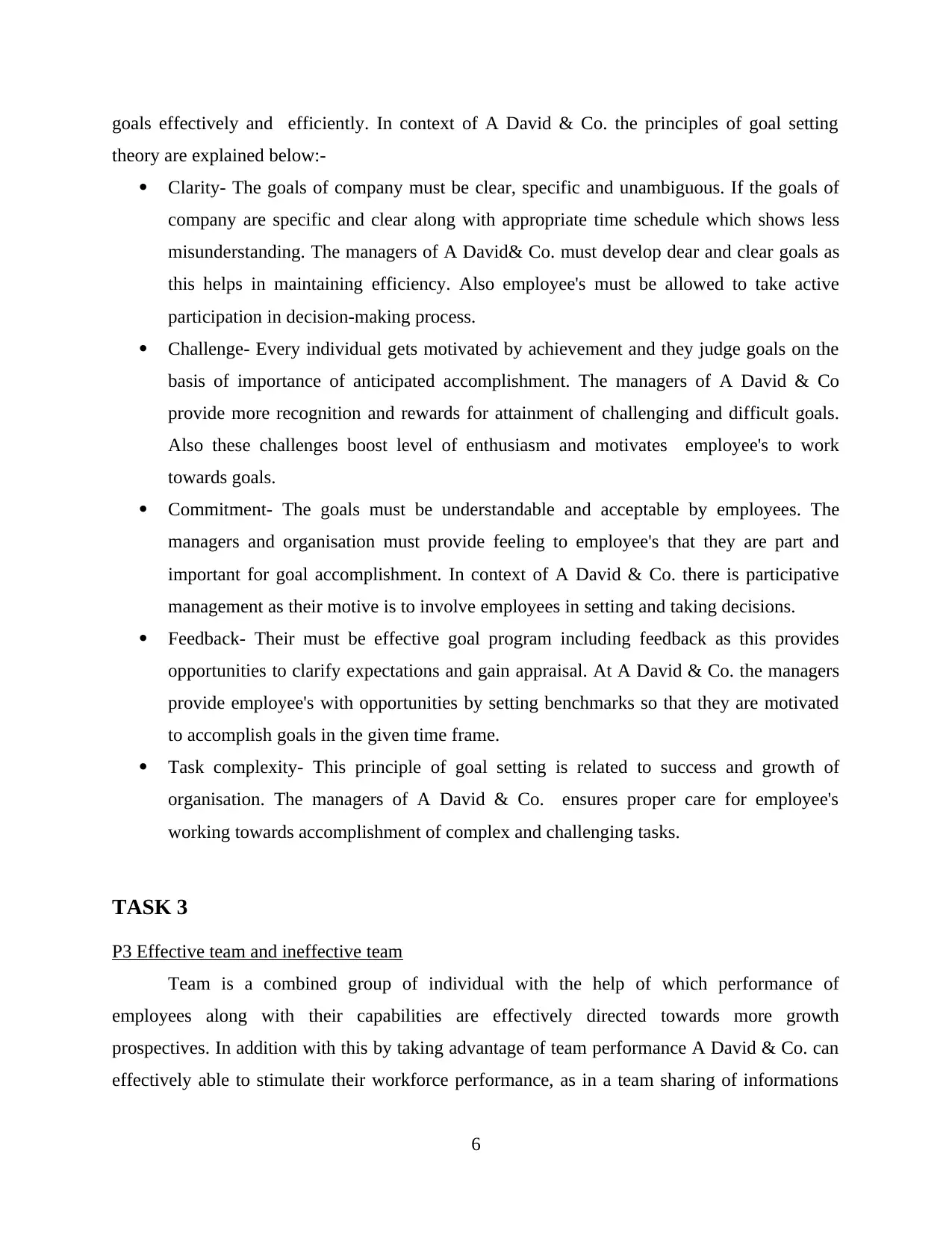
goals effectively and efficiently. In context of A David & Co. the principles of goal setting
theory are explained below:-
Clarity- The goals of company must be clear, specific and unambiguous. If the goals of
company are specific and clear along with appropriate time schedule which shows less
misunderstanding. The managers of A David& Co. must develop dear and clear goals as
this helps in maintaining efficiency. Also employee's must be allowed to take active
participation in decision-making process.
Challenge- Every individual gets motivated by achievement and they judge goals on the
basis of importance of anticipated accomplishment. The managers of A David & Co
provide more recognition and rewards for attainment of challenging and difficult goals.
Also these challenges boost level of enthusiasm and motivates employee's to work
towards goals.
Commitment- The goals must be understandable and acceptable by employees. The
managers and organisation must provide feeling to employee's that they are part and
important for goal accomplishment. In context of A David & Co. there is participative
management as their motive is to involve employees in setting and taking decisions.
Feedback- Their must be effective goal program including feedback as this provides
opportunities to clarify expectations and gain appraisal. At A David & Co. the managers
provide employee's with opportunities by setting benchmarks so that they are motivated
to accomplish goals in the given time frame.
Task complexity- This principle of goal setting is related to success and growth of
organisation. The managers of A David & Co. ensures proper care for employee's
working towards accomplishment of complex and challenging tasks.
TASK 3
P3 Effective team and ineffective team
Team is a combined group of individual with the help of which performance of
employees along with their capabilities are effectively directed towards more growth
prospectives. In addition with this by taking advantage of team performance A David & Co. can
effectively able to stimulate their workforce performance, as in a team sharing of informations
6
theory are explained below:-
Clarity- The goals of company must be clear, specific and unambiguous. If the goals of
company are specific and clear along with appropriate time schedule which shows less
misunderstanding. The managers of A David& Co. must develop dear and clear goals as
this helps in maintaining efficiency. Also employee's must be allowed to take active
participation in decision-making process.
Challenge- Every individual gets motivated by achievement and they judge goals on the
basis of importance of anticipated accomplishment. The managers of A David & Co
provide more recognition and rewards for attainment of challenging and difficult goals.
Also these challenges boost level of enthusiasm and motivates employee's to work
towards goals.
Commitment- The goals must be understandable and acceptable by employees. The
managers and organisation must provide feeling to employee's that they are part and
important for goal accomplishment. In context of A David & Co. there is participative
management as their motive is to involve employees in setting and taking decisions.
Feedback- Their must be effective goal program including feedback as this provides
opportunities to clarify expectations and gain appraisal. At A David & Co. the managers
provide employee's with opportunities by setting benchmarks so that they are motivated
to accomplish goals in the given time frame.
Task complexity- This principle of goal setting is related to success and growth of
organisation. The managers of A David & Co. ensures proper care for employee's
working towards accomplishment of complex and challenging tasks.
TASK 3
P3 Effective team and ineffective team
Team is a combined group of individual with the help of which performance of
employees along with their capabilities are effectively directed towards more growth
prospectives. In addition with this by taking advantage of team performance A David & Co. can
effectively able to stimulate their workforce performance, as in a team sharing of informations
6
⊘ This is a preview!⊘
Do you want full access?
Subscribe today to unlock all pages.

Trusted by 1+ million students worldwide
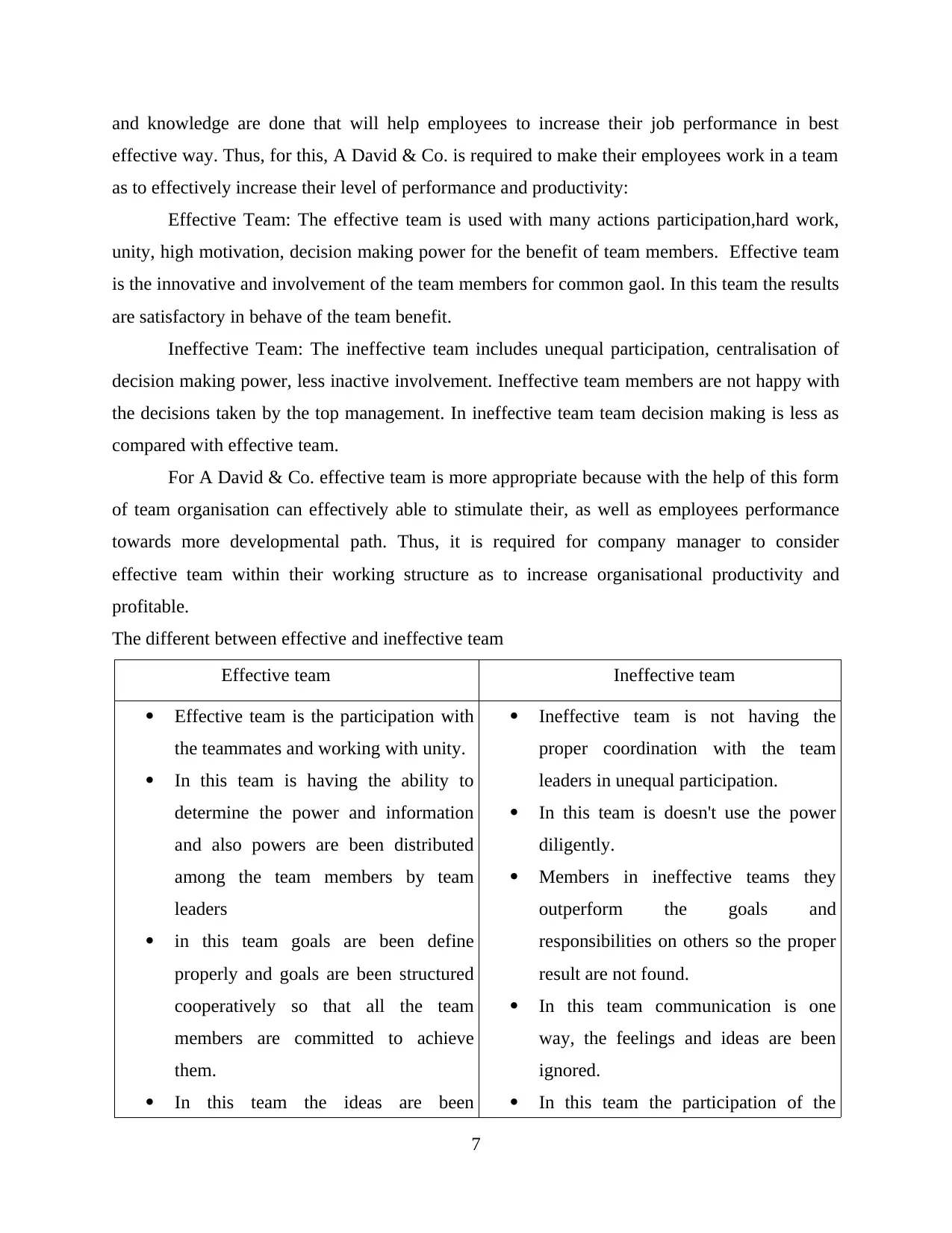
and knowledge are done that will help employees to increase their job performance in best
effective way. Thus, for this, A David & Co. is required to make their employees work in a team
as to effectively increase their level of performance and productivity:
Effective Team: The effective team is used with many actions participation,hard work,
unity, high motivation, decision making power for the benefit of team members. Effective team
is the innovative and involvement of the team members for common gaol. In this team the results
are satisfactory in behave of the team benefit.
Ineffective Team: The ineffective team includes unequal participation, centralisation of
decision making power, less inactive involvement. Ineffective team members are not happy with
the decisions taken by the top management. In ineffective team team decision making is less as
compared with effective team.
For A David & Co. effective team is more appropriate because with the help of this form
of team organisation can effectively able to stimulate their, as well as employees performance
towards more developmental path. Thus, it is required for company manager to consider
effective team within their working structure as to increase organisational productivity and
profitable.
The different between effective and ineffective team
Effective team Ineffective team
Effective team is the participation with
the teammates and working with unity.
In this team is having the ability to
determine the power and information
and also powers are been distributed
among the team members by team
leaders
in this team goals are been define
properly and goals are been structured
cooperatively so that all the team
members are committed to achieve
them.
In this team the ideas are been
Ineffective team is not having the
proper coordination with the team
leaders in unequal participation.
In this team is doesn't use the power
diligently.
Members in ineffective teams they
outperform the goals and
responsibilities on others so the proper
result are not found.
In this team communication is one
way, the feelings and ideas are been
ignored.
In this team the participation of the
7
effective way. Thus, for this, A David & Co. is required to make their employees work in a team
as to effectively increase their level of performance and productivity:
Effective Team: The effective team is used with many actions participation,hard work,
unity, high motivation, decision making power for the benefit of team members. Effective team
is the innovative and involvement of the team members for common gaol. In this team the results
are satisfactory in behave of the team benefit.
Ineffective Team: The ineffective team includes unequal participation, centralisation of
decision making power, less inactive involvement. Ineffective team members are not happy with
the decisions taken by the top management. In ineffective team team decision making is less as
compared with effective team.
For A David & Co. effective team is more appropriate because with the help of this form
of team organisation can effectively able to stimulate their, as well as employees performance
towards more developmental path. Thus, it is required for company manager to consider
effective team within their working structure as to increase organisational productivity and
profitable.
The different between effective and ineffective team
Effective team Ineffective team
Effective team is the participation with
the teammates and working with unity.
In this team is having the ability to
determine the power and information
and also powers are been distributed
among the team members by team
leaders
in this team goals are been define
properly and goals are been structured
cooperatively so that all the team
members are committed to achieve
them.
In this team the ideas are been
Ineffective team is not having the
proper coordination with the team
leaders in unequal participation.
In this team is doesn't use the power
diligently.
Members in ineffective teams they
outperform the goals and
responsibilities on others so the proper
result are not found.
In this team communication is one
way, the feelings and ideas are been
ignored.
In this team the participation of the
7
Paraphrase This Document
Need a fresh take? Get an instant paraphrase of this document with our AI Paraphraser
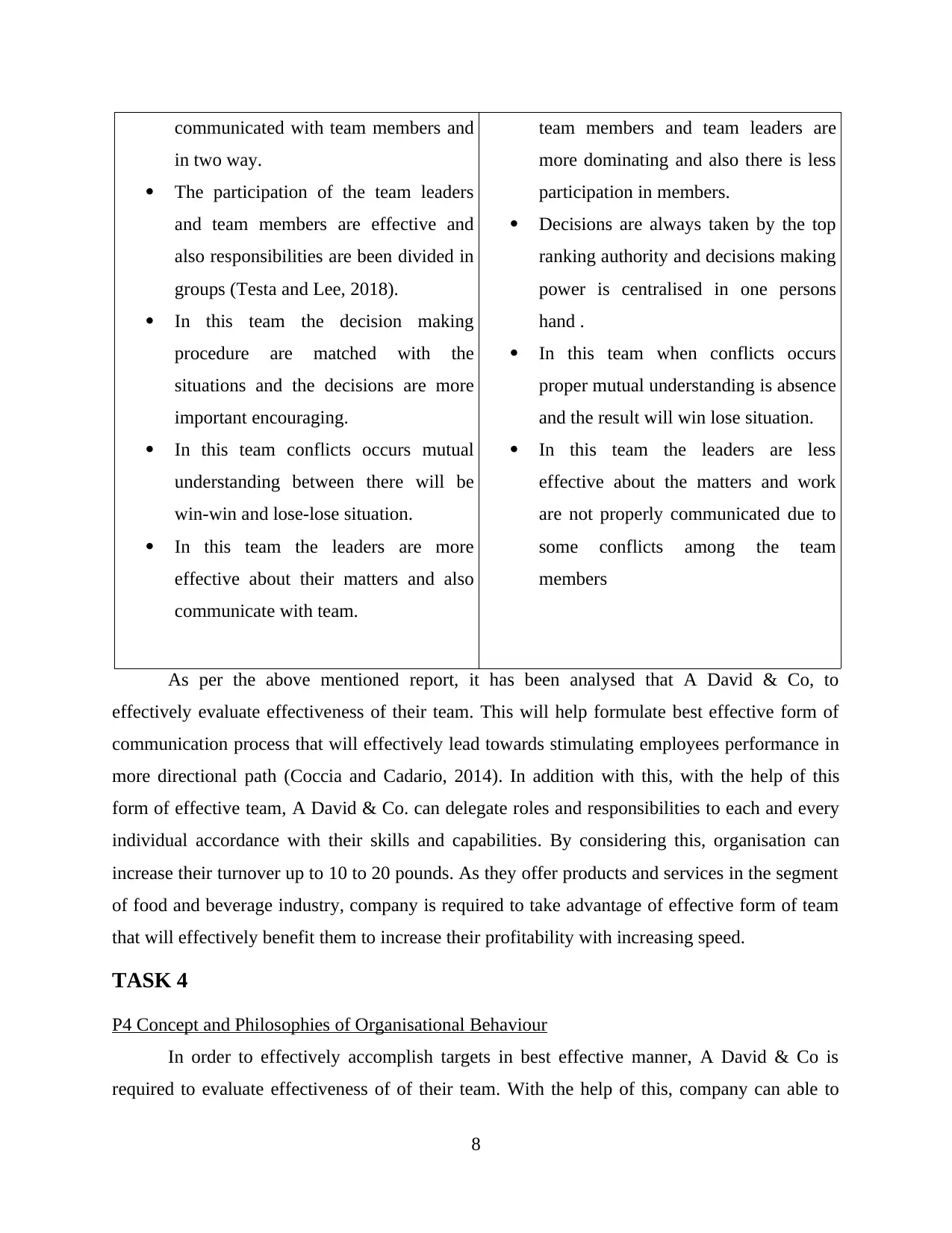
communicated with team members and
in two way.
The participation of the team leaders
and team members are effective and
also responsibilities are been divided in
groups (Testa and Lee, 2018).
In this team the decision making
procedure are matched with the
situations and the decisions are more
important encouraging.
In this team conflicts occurs mutual
understanding between there will be
win-win and lose-lose situation.
In this team the leaders are more
effective about their matters and also
communicate with team.
team members and team leaders are
more dominating and also there is less
participation in members.
Decisions are always taken by the top
ranking authority and decisions making
power is centralised in one persons
hand .
In this team when conflicts occurs
proper mutual understanding is absence
and the result will win lose situation.
In this team the leaders are less
effective about the matters and work
are not properly communicated due to
some conflicts among the team
members
As per the above mentioned report, it has been analysed that A David & Co, to
effectively evaluate effectiveness of their team. This will help formulate best effective form of
communication process that will effectively lead towards stimulating employees performance in
more directional path (Coccia and Cadario, 2014). In addition with this, with the help of this
form of effective team, A David & Co. can delegate roles and responsibilities to each and every
individual accordance with their skills and capabilities. By considering this, organisation can
increase their turnover up to 10 to 20 pounds. As they offer products and services in the segment
of food and beverage industry, company is required to take advantage of effective form of team
that will effectively benefit them to increase their profitability with increasing speed.
TASK 4
P4 Concept and Philosophies of Organisational Behaviour
In order to effectively accomplish targets in best effective manner, A David & Co is
required to evaluate effectiveness of of their team. With the help of this, company can able to
8
in two way.
The participation of the team leaders
and team members are effective and
also responsibilities are been divided in
groups (Testa and Lee, 2018).
In this team the decision making
procedure are matched with the
situations and the decisions are more
important encouraging.
In this team conflicts occurs mutual
understanding between there will be
win-win and lose-lose situation.
In this team the leaders are more
effective about their matters and also
communicate with team.
team members and team leaders are
more dominating and also there is less
participation in members.
Decisions are always taken by the top
ranking authority and decisions making
power is centralised in one persons
hand .
In this team when conflicts occurs
proper mutual understanding is absence
and the result will win lose situation.
In this team the leaders are less
effective about the matters and work
are not properly communicated due to
some conflicts among the team
members
As per the above mentioned report, it has been analysed that A David & Co, to
effectively evaluate effectiveness of their team. This will help formulate best effective form of
communication process that will effectively lead towards stimulating employees performance in
more directional path (Coccia and Cadario, 2014). In addition with this, with the help of this
form of effective team, A David & Co. can delegate roles and responsibilities to each and every
individual accordance with their skills and capabilities. By considering this, organisation can
increase their turnover up to 10 to 20 pounds. As they offer products and services in the segment
of food and beverage industry, company is required to take advantage of effective form of team
that will effectively benefit them to increase their profitability with increasing speed.
TASK 4
P4 Concept and Philosophies of Organisational Behaviour
In order to effectively accomplish targets in best effective manner, A David & Co is
required to evaluate effectiveness of of their team. With the help of this, company can able to
8
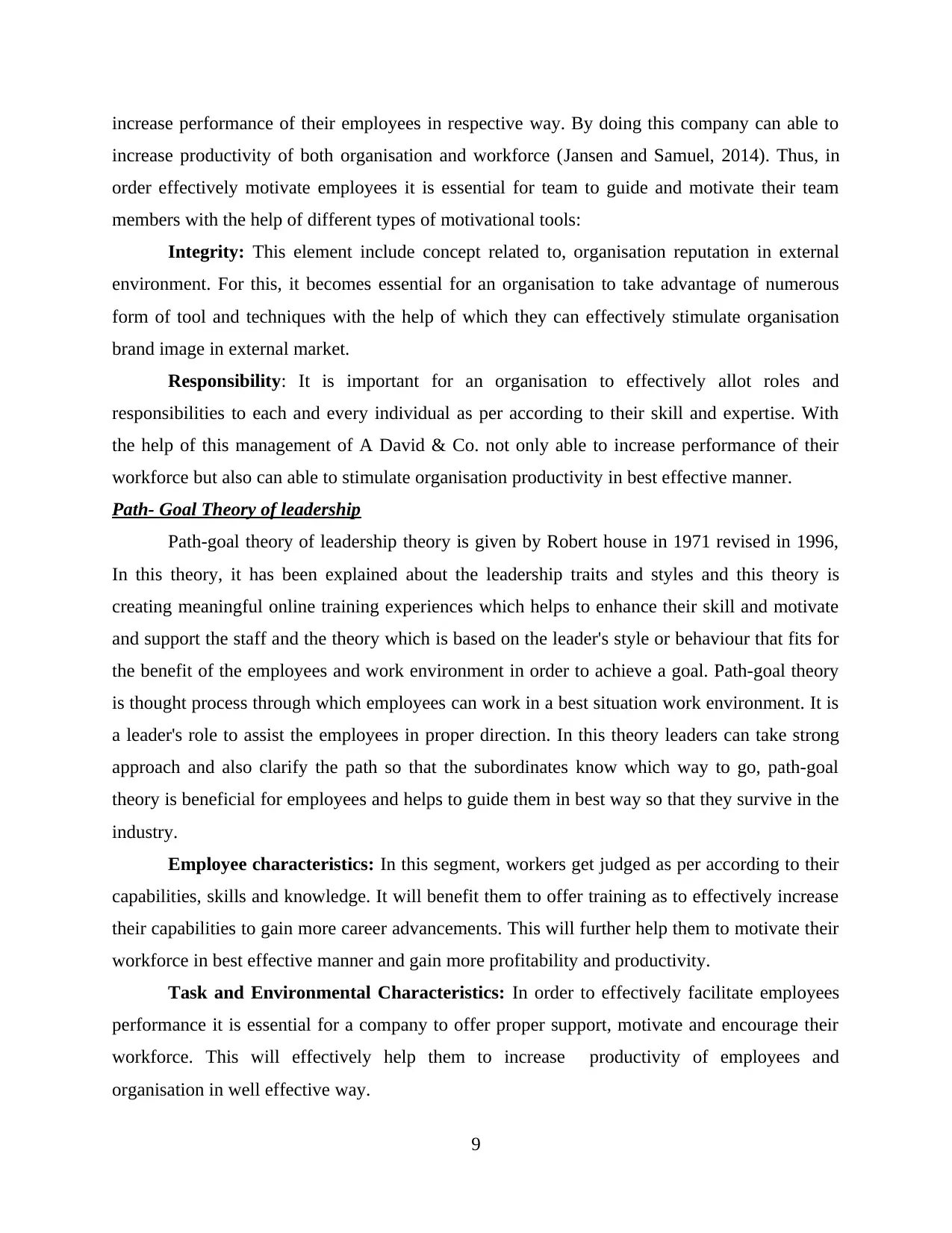
increase performance of their employees in respective way. By doing this company can able to
increase productivity of both organisation and workforce (Jansen and Samuel, 2014). Thus, in
order effectively motivate employees it is essential for team to guide and motivate their team
members with the help of different types of motivational tools:
Integrity: This element include concept related to, organisation reputation in external
environment. For this, it becomes essential for an organisation to take advantage of numerous
form of tool and techniques with the help of which they can effectively stimulate organisation
brand image in external market.
Responsibility: It is important for an organisation to effectively allot roles and
responsibilities to each and every individual as per according to their skill and expertise. With
the help of this management of A David & Co. not only able to increase performance of their
workforce but also can able to stimulate organisation productivity in best effective manner.
Path- Goal Theory of leadership
Path-goal theory of leadership theory is given by Robert house in 1971 revised in 1996,
In this theory, it has been explained about the leadership traits and styles and this theory is
creating meaningful online training experiences which helps to enhance their skill and motivate
and support the staff and the theory which is based on the leader's style or behaviour that fits for
the benefit of the employees and work environment in order to achieve a goal. Path-goal theory
is thought process through which employees can work in a best situation work environment. It is
a leader's role to assist the employees in proper direction. In this theory leaders can take strong
approach and also clarify the path so that the subordinates know which way to go, path-goal
theory is beneficial for employees and helps to guide them in best way so that they survive in the
industry.
Employee characteristics: In this segment, workers get judged as per according to their
capabilities, skills and knowledge. It will benefit them to offer training as to effectively increase
their capabilities to gain more career advancements. This will further help them to motivate their
workforce in best effective manner and gain more profitability and productivity.
Task and Environmental Characteristics: In order to effectively facilitate employees
performance it is essential for a company to offer proper support, motivate and encourage their
workforce. This will effectively help them to increase productivity of employees and
organisation in well effective way.
9
increase productivity of both organisation and workforce (Jansen and Samuel, 2014). Thus, in
order effectively motivate employees it is essential for team to guide and motivate their team
members with the help of different types of motivational tools:
Integrity: This element include concept related to, organisation reputation in external
environment. For this, it becomes essential for an organisation to take advantage of numerous
form of tool and techniques with the help of which they can effectively stimulate organisation
brand image in external market.
Responsibility: It is important for an organisation to effectively allot roles and
responsibilities to each and every individual as per according to their skill and expertise. With
the help of this management of A David & Co. not only able to increase performance of their
workforce but also can able to stimulate organisation productivity in best effective manner.
Path- Goal Theory of leadership
Path-goal theory of leadership theory is given by Robert house in 1971 revised in 1996,
In this theory, it has been explained about the leadership traits and styles and this theory is
creating meaningful online training experiences which helps to enhance their skill and motivate
and support the staff and the theory which is based on the leader's style or behaviour that fits for
the benefit of the employees and work environment in order to achieve a goal. Path-goal theory
is thought process through which employees can work in a best situation work environment. It is
a leader's role to assist the employees in proper direction. In this theory leaders can take strong
approach and also clarify the path so that the subordinates know which way to go, path-goal
theory is beneficial for employees and helps to guide them in best way so that they survive in the
industry.
Employee characteristics: In this segment, workers get judged as per according to their
capabilities, skills and knowledge. It will benefit them to offer training as to effectively increase
their capabilities to gain more career advancements. This will further help them to motivate their
workforce in best effective manner and gain more profitability and productivity.
Task and Environmental Characteristics: In order to effectively facilitate employees
performance it is essential for a company to offer proper support, motivate and encourage their
workforce. This will effectively help them to increase productivity of employees and
organisation in well effective way.
9
⊘ This is a preview!⊘
Do you want full access?
Subscribe today to unlock all pages.

Trusted by 1+ million students worldwide
1 out of 17
Related Documents
Your All-in-One AI-Powered Toolkit for Academic Success.
+13062052269
info@desklib.com
Available 24*7 on WhatsApp / Email
![[object Object]](/_next/static/media/star-bottom.7253800d.svg)
Unlock your academic potential
Copyright © 2020–2025 A2Z Services. All Rights Reserved. Developed and managed by ZUCOL.





